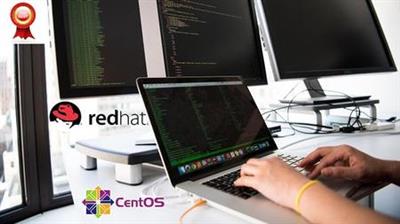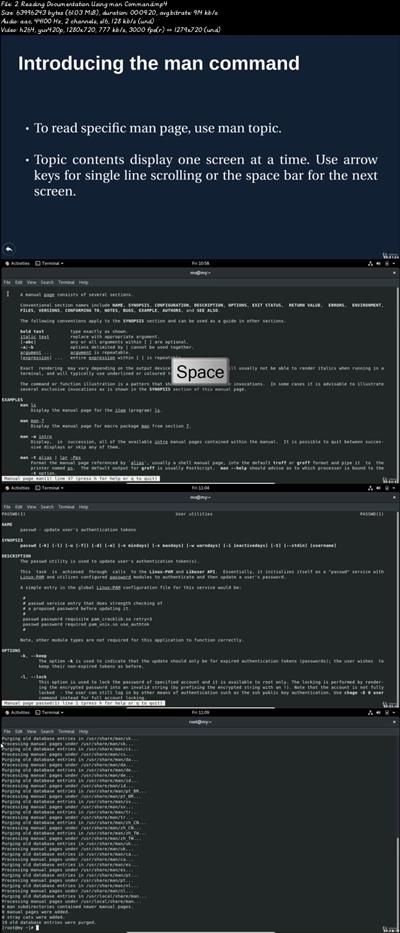RHEL 8/CentOS 8 Linux System Administration (RHCSA) Level I
Video: .mp4 (1280x720, 30 fps(r)) | Audio: aac, 44100 Hz, 2ch | Size: 1.93 GB
Genre: eLearning Video | Duration: 84 lectures (5 hour, 45 mins) | Language: English
Learn Linux system administrator essential skills/fundamentals and prepare for the Red hat Certified System Admin exam.
What you'll learn
You will be prepared for the Red hat Certified System Administrator (RHCSA) exam.
You will learn, the fundamentals of the Linux operating system using RHEL 8/CentOS 8.
You will learn, Linux system administrator essential skills and how to run and manage the Linux operating system professionally.
You will learn, the most popular and most used Linux commands.
You will learn, Linux custom storage configuration.
You will learn, the LVM Partition scheme.
You will learn, accessing Linux virtual consoles.
You will learn, the Linux shell basics.
You will learn, the environment configuration files.
You will learn, the shell commands typing rules.
You will learn, the Linux quick start commands.
You will learn, the Linux relative and absolute paths.
You will learn, the Linux shell special keys.
You will learn, the Linux file system hierarchy.
You will learn, the most important directories on the Linux system.
You will learn, the Linux command-line file management.
You will learn, matching file names using Path Name Expansion 'Globbing and Wildcards'.
You will be able to access the Linux operating system graphically and from the command line.
You will be able to get help in Linux graphically and from the command-line using different tools.
Requirements
There are no requirements necessary to enroll, I only ask you to come open-minded and ready to learn.
Description
JOIN THE BEST LINUX SYSTEM (SERVER/DESKTOP) ADMINISTRATION COURSE FOR NEWBIE LINUX USERS USING RHEL 8/CENTOS 8 LINUX!!
Hi. My name is Mustafa and I'm the author of the 'RHEL 8/CentOS 8 Linux System Administration (RHCSA) Level I' course. I started working as a network and computer systems administrator since January 2011. I have a bachelor degree in engineering from Alexandria University, Egypt. After finishing university, I concentrated on learning the Linux system administration. I have many certifications in Linux system administration, network administration, database administration, and some programming languages 'C, C++, and Python'. I have a large experience in working on Linux using RHEL, CentOS, and Ubuntu Linux distributions. I have a desire to teach others and transfer my experience to them in an easy and simplified way.
The Course 3 Levels will cover all the topics of the Red Hat Certified System Administrator (RHCSA) and Red Hat Certified Engineer (RHCE). The RHCSA will be in 2 Levels and the RHCE will be in 1 Level, using CentOS 8.
RHEL 8/CentOS 8 Linux System Administration RHCSA Level One Content:
Linux System Administration Intro:
Linux system administration introduction.
The Linux system administrator's major duties.
The main differences between CentOS and RHEL.
Linux System Administrator Essential Skills which will include:
VirtualBox Download and Install.
Creating a CentOS 8 Virtual Machine.
CentOS 8 Download and Install.
CentOS 8 installation requirements.
Using Automatic Storage configuration.
Using Custom Storage configuration.
LVM Partition scheme.
Adding new mount points 'partitions'.
The XFS file system.
Adjusting the resolution to view a full-resolution CentOS VM on your computer.
Linux systems basic modes.
CentOS 8 Graphical user interface.
Connecting to the system using graphical mode.
Visual overview of GNOME 3.
The top bar.
The system menu in the top bar.
Activities button overview.
Starting applications.
Workspaces.
Switching between workspaces.
Launching an application in a separate workspace.
Launching an application in a new workspace.
Quickly running a command.
Application menu.
Clock and calendar button.
New Boxes features.
The System menu.
Locking the screen.
Switching users.
Suspending the computer.
Powering off the computer.
Switching between windows.
The difference between terminal and shell.
Launching the terminal window.
The terminal window command prompt.
Checking your hostname '$HOSTNAME'.
Switching to root user.
Disconnecting from the system in graphical mode.
Centos 8 Virtual Consoles.
The text mode login screen.
Logging in using a virtual console.
The tty command.
The logout command.
The Shell Basics.
The bash shell.
The shell commands basic parts.
The shell alias.
Bash builtin commands.
The external commands.
The $PATH environmental variable.
The which command.
The echo command.
The env command.
Changing directories in the PATH variable.
The export command.
The environment configuration files.
The /etc/profile, /etc/bashrc, ~/.bash_profile, and ~/.bashrc files.
Using /etc/motd and /etc/issue files.
Shell commands typing rules.
Quick Start Commands.
The date command.
The pwd command.
The cd command.
Relative and absolute paths.
The passwd command.
The file command.
The head and tail commands.
The wc command.
The cat command.
The exit command.
The ls command.
The history command.
The exclamation point character ( ! ).
The Shell Special Keys.
Managing Files from the Command-line which will include:
The Linux file system hierarchy.
The Linux file system tree-like structure.
The most important directories on the Linux system.
Command-line file management.
Creating, deleting, copying, and moving files and directories.
The touch command.
More options for cd and ls commands.
Matching File Names Using Path Name Expansion 'Globbing and Wildcards'.
The common meta-characters and pattern classes.
Simple pattern matches using ( ? ).
Tilde expansion ( ~ ).
Brace expansion.
Command substitution.
Protecting arguments from expansion.
Getting Help in Linux which will include:
Reading Documentation using man command.
Sections of the Linux manual.
Sections containing popular system administration topics.
Identifying man pages by keyword.
Navigating man pages.
Searching for man pages by keyword.
The apropos command.
The mandb command.
Reading Documentation using Info command.
Reading Documentation using pinfo command.
The INFOPATH environment variable.
Reading Documentation in usr/share/doc directory.
The whatis command.
The -help option.
Graphical help.
The gnome-help command.
The yelp command.
The shell built-in commands.
Creating, Viewing, and Editing Text Files in Linux which will include:
Describing the technical terms of standard input, standard output, and standard error.
The file descriptors.
Using the redirection characters to control output to files.
Output redirection operators.
Constructing pipelines.
Using piping to control output to other programs.
Using the tee command for piping.
Creating new files and editing existing text files from the shell prompt.
Navigating within an editor to effectively accomplish editing tasks.
Using the Vim editor in the basic editing tasks.
Different ways of launching gedit.
Basic gedit keystrokes.
Editing text files with gedit.
Copying text between graphical windows.
Managing Local Linux Users & Groups which will include:
What a multi-user system is.
Using the id command.
Using the ps command.
The /etc/passwd file.
What a group is.
The /etc/group file.
The primary groups.
The supplementary groups.
What a root user is.
Switching users with the su command.
Running commands as root with the sudo command.
The /etc/sudoers file.
The group wheel.
The PolicyKit.
Managing local users.
The useradd command.
The /etc/login.defs file.
The usermod command.
The userdel command.
The id command.
The passwd command.
The UID ranges.
Managing supplementary groups.
The groupadd command.
The groupmod command.
The groupdel command.
The usermod command.
Shadow passwords and password policy.
The /etc/shadow file.
The authselect command.
Password aging.
The chage command.
Using the date command to calculate a date in the future.
Restricting access.
The nologin shell.
Controlling Access to Files with Linux File System Permissions which will include:
Linux File System Permissions.
Effects of permissions on files and directories.
Viewing file/directory permissions and ownership.
What the Security-Enhanced Linux (SELinux) is?
Practical examples of controlling permissions and their allowed and denied behaviour.
Managing File System Permissions from the Command-Line.
Changing file/directory permissions.
The Symbolic method keywords.
The Numeric method.
Practical examples of controlling permissions using the Symbolic and Numeric methods.
Changing file/directory user or group ownership.
The chown command.
The chgrp command.
Managing Default Permissions and File Access.
Special permissions.
The setuid permission.
The setgid permission.
The sticky bit permission.
Effects of special permissions on files and directories.
Setting special permissions.
Default file permissions.
The umask command.
And practical examples of using the umask command.
#The course contains two practice test and three quizzes.
#A private Facebook group is available for answering the students' inquiries regarding the course.
ENROLL NOW AND ENJOY LEARNING THE LINUX FUNDAMENTALS / LINUX ESSENTIAL SKILLS!!
Who this course is for:
Anyone want to be prepared for the Red hat Certified System Administrator (RHCSA) exam.
Anyone who wants to start a new career as a professional Linux system administrator.
Anyone who needs to learn Linux for a personal or business project.
A newbie Linux user who wants to be professional in using Linux.
An existing Linux user who wants to increase his knowledge.
Windows or macOS users who want to switch to Linux.
Anyone with a desire to learn Linux.
Student testimonials:
Joseph DcruzUpdated: Instructor was really good and well explained. Valuable information, clear explanations, engaging delivery, helpful practice activities, accurate course description, and knowledgeable instructor.
Ahmed Salah: Excellent course with an excellent and expert instructor.
Who this course is for:
The ideal student for this course is anyone seeking to learn the Linux Fundamentals / Linux Essential skills from scratch step by step.
Download link:Kod:rapidgator_net: https://rapidgator.net/file/f64e049719c45f8ec4409e66cefc3258/xdj7i.RHEL.8CentOS.8.Linux.System.Administration.RHCSA.Level.I.part1.rar.html https://rapidgator.net/file/986815fe204d10649f2e1ebf67153b7c/xdj7i.RHEL.8CentOS.8.Linux.System.Administration.RHCSA.Level.I.part2.rar.html nitroflare_com: https://nitroflare.com/view/41838CBC9FD5CBB/xdj7i.RHEL.8CentOS.8.Linux.System.Administration.RHCSA.Level.I.part1.rar https://nitroflare.com/view/76281A194EE97E9/xdj7i.RHEL.8CentOS.8.Linux.System.Administration.RHCSA.Level.I.part2.rarLinks are Interchangeable - No Password - Single Extraction
1 sonuçtan 1 ile 1 arası
-
19.04.2020 #1Üye



- Üyelik tarihi
- 20.08.2016
- Mesajlar
- 148.472
- Konular
- 0
- Bölümü
- Bilgisayar
- Cinsiyet
- Kadın
- Tecrübe Puanı
- 158
RHEL 8CentOS 8 Linux System Administration (RHCSA) Level I
Konu Bilgileri
Users Browsing this Thread
Şu an 1 kullanıcı var. (0 üye ve 1 konuk)



 LinkBack URL
LinkBack URL About LinkBacks
About LinkBacks






 Alıntı
Alıntı
Konuyu Favori Sayfanıza Ekleyin